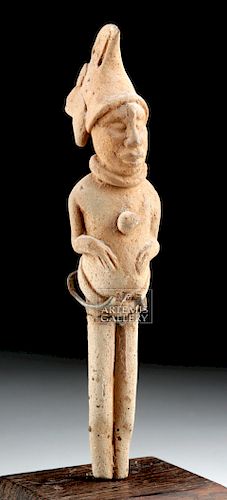Maya Jaina Pottery Standing Figural Whistle
Lot 414
About Seller
Artemis Gallery
686 S Taylor Ave, Ste 106
Louisville, CO 80027
United States
Selling antiquities, ancient and ethnographic art online since 1993, Artemis Gallery specializes in Classical Antiquities (Egyptian, Greek, Roman, Near Eastern), Asian, Pre-Columbian, African / Tribal / Oceanographic art. Our extensive inventory includes pottery, stone, metal, wood, glass and textil...Read more
Estimate:
$2,200 - $3,300
Absentee vs Live bid
Two ways to bid:
- Leave a max absentee bid and the platform will bid on your behalf up to your maximum bid during the live auction.
- Bid live during the auction and your bids will be submitted real-time to the auctioneer.
Bid Increments
| Price | Bid Increment |
|---|---|
| $0 | $25 |
| $300 | $50 |
| $1,000 | $100 |
| $2,000 | $250 |
| $5,000 | $500 |
| $10,000 | $1,000 |
| $20,000 | $2,500 |
| $50,000 | $5,000 |
| $100,000 | $10,000 |
| $200,000 | $20,000 |
About Auction
By Artemis Gallery
Oct 17, 2019
Set Reminder
2019-10-17 10:00:00
2019-10-17 10:00:00
America/New_York
Bidsquare
Bidsquare : Early Fall Variety | Ancient & Ethnographic
https://www.bidsquare.com/auctions/artemis-gallery/early-fall-variety-ancient-ethnographic-4538
Discover incredible lots relisted with new, lower start prices (up to 50% less), plus many items brand-new to auction. Step back in time and around the world – you’ll be amazed at the treasures you will find. Antiquities from the Classics, Asian, Pre-Columbian African and much more! Artemis Gallery info@artemisgallery.com
Discover incredible lots relisted with new, lower start prices (up to 50% less), plus many items brand-new to auction. Step back in time and around the world – you’ll be amazed at the treasures you will find. Antiquities from the Classics, Asian, Pre-Columbian African and much more! Artemis Gallery info@artemisgallery.com
- Lot Description
**Originally Listed At $1200**
Pre-Columbian, southeastern Mexico, Yucatan Peninsula, Campeche, Jaina Island, Maya, Late Classic Period, ca. 600 to 850 CE. A beautiful mold-formed pottery whistle in the form of a standing anthropomorphic figure. The figure stands atop fused hollow legs which double as the instrument's mouthpiece, holds bent arms against a bulbous belly above a simple loin cloth, and has a spherical orb protruding from the center of the chest. The head boasts a highly-stylized countenance replete with almond-shaped eyes, puffy brows which narrow to a wide nose, full lips with a tooled philtrum, and smooth cheeks, all beneath an elaborate headdress depicting the head of a raptorial bird. The whistle is painted with a pale-orange slip, and a pair of tone holes on the verso double as a suspension loop. The whistle produces no sound when played. Custom wooden display stand included. Size: 1.25" W x 6.125" H (3.2 cm x 15.6 cm); 7.6" H (19.3 cm) on included custom stand.
Jaina figures, from an island off the Yucatan Peninsula, are noted for their lifelike faces and their immense detail. The clothing that this figure wears almost certainly copies the real clothing of a person in the Late Classic Maya period. These figures suggest that they are representative of actual people, some of which were produced in Campeche and brought to Jaina Island to be buried with the dead. Fascinatingly, the people around Jaina are the only people in southeastern Mesoamerica who put human figures into graves - figures have only been found in domestic contexts most everywhere else in this region.
Provenance: private Southern California, USA collection, acquired in the 1970s to mid-1980s
All items legal to buy/sell under U.S. Statute covering cultural patrimony Code 2600, CHAPTER 14, and are guaranteed to be as described or your money back.
A Certificate of Authenticity will accompany all winning bids.
We ship worldwide and handle all shipping in-house for your convenience.
#144524Both legs reattached just below waist line with small chips and light adhesive residue along break lines. Minor abrasions and nicks to legs, body, and head, with fading to original pigmentation, and light encrustations. Nice earthen deposits throughout. Whistle produces no sound when played.Condition
- Shipping Info
-
All shipping is handled in-house for your convenience. Your invoice from Artemis Gallery will include shipping calculation instructions. If in doubt, please inquire BEFORE bidding for estimated shipping costs for individual items.
-
- Buyer's Premium



 EUR
EUR CAD
CAD AUD
AUD GBP
GBP MXN
MXN HKD
HKD CNY
CNY MYR
MYR SEK
SEK SGD
SGD CHF
CHF THB
THB














